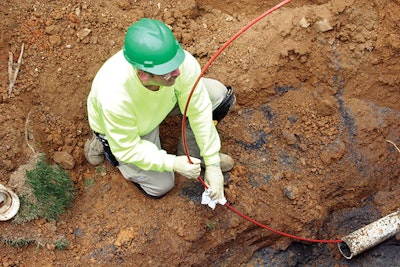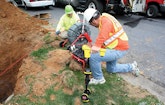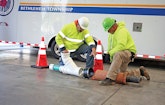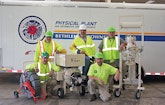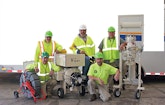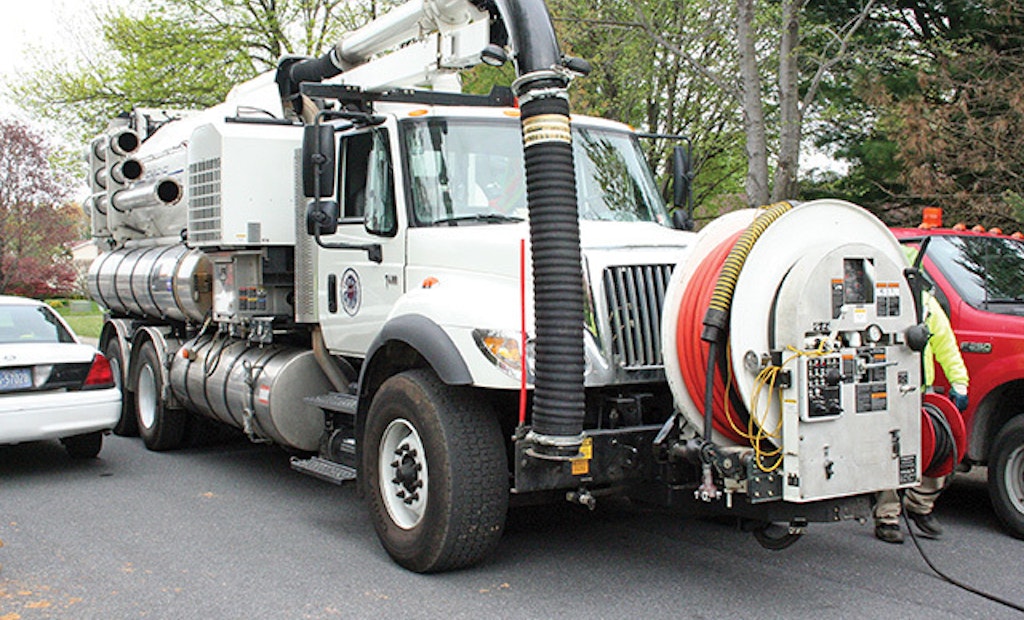Interested in Cleaning?
Get Cleaning articles, news and videos right in your inbox! Sign up now.
Cleaning + Get AlertsBethlehem Township is fortunate to have a relatively young sewer collection system, with most of the lines built during a federally funded construction boom during the 1970s. The one sore spot in the township’s system is a root-infested subdivision with vitrified clay collection lines. By building an in-house capacity for cured-in-place pipe (CIPP) lining, Bethlehem Township Municipal Authority (BTMA) will not only add valuable personnel skills and equipment to its inventory, it will save the township a lot of money.
The township is located about a 90-minute drive north of Philadelphia. The system serves Bethlehem Township and some additional areas, including adjoining sections of Palmer, Hanover and Lower Nazarene townships. Steve Hunsberger is director of the Physical Plant and Information Services Division with BTMA, and director of the authority, a non-compensated position. He has worked with BTMA for 36 years and been in charge of the wastewater collection system since 1988.
“The oldest sewer line in the system was built in 1978 and in the world of sewers, that’s a relatively young system,” says Hunsberger. “The majority of this system is made of transite cement-asbestos pipe and when we need to replace any section, we do it with SDR-35 PVC.”
The exception is Devonshire Village, a subdivision built by developers between 1978 and 1980. While development homes were built with on-lot disposal systems, an agreement with the township required the developers to build a capped sewer system that could eventually be tied into future conveyance lines. The small collection system was designed to serve 84 homes with 5,300 feet of 8-inch mainline and 2,300 feet of 6-inch laterals.
Sewer system unused
“The collection system was built of vitrified clay, probably an example of the last wave of construction of that material,” says Hunsberger. “The sewer system just sat there unused for six years and in 1986 we finally reached it with our conveyance system and connected the development. Right from the start, we had problems with heavy root penetration and broken pipe. Street trees were planted along the curbs and their roots just had a field day with the pipe. In some cases, other utilities had been cut right through the previously unused service. At the same time, the connections from the homes to the 6-inch service were inferior, with the transitions using just a rubber O-ring and some cement.”
As the years passed, root intrusion became a more serious problem, with significant maintenance attention focused on the subdivision.
John Bartholomew is a BTMA technician responsible for the township’s closed circuit camera inspections, which utilize a Pearpoint CCTV camera from SPX Corporation.
“We like to televise the entire system, which takes about four years, then start all over again,” says Bartholomew. “It’s an ongoing process. We’ve been in that development and we’ve seen the heavy root intrusion. We’ve tried cutting out the roots and we’ve tried root foaming, which we can now handle in-house with the purchase of an injection system, but we weren’t impressed with the results.”
The subdivision’s system continued to perform so poorly and required so much maintenance that the authority began to examine two scenarios: dig and replace the entire system, or reline the entire system. The cost of traditional trenching and replacement of all the sewer mains and laterals was estimated in the millions of dollars. Based on regional per-foot prices offered by private contractors for similar projects, the cost of relining the mains and laterals was estimated at about $840,000.
“The private sector is in the business to make money,” says Hunsberger. “We saw our business as saving money for ratepayers. At this point, we began to examine some way to do this relining work ourselves and come out ahead.”
After examining the options, the department recommended purchasing the Perma-Liner Top Gun system, using an epoxy resin lining, to the authority board.
Crunching the numbers
“After crunching the numbers, we believed we could complete the project for around $634,000, including the cost of staff labor,” says Hunsberger. “Although labor is a hard cost, it was a cost we realized we paid regardless of the tasks assigned to our staff. So to get an actual look at the savings, we subtracted another $106,000 in labor costs. We were now looking at $528,000 for all mainlining equipment and lining materials. At the end of this first project, our staff would be trained in CIPP lining and the department would own a valuable steam-cured relining system. It would all be paid for on the very first job.”
In selling the project to the BTMA board, Hunsberger presented a worst-case scenario. If any part of the relining process failed, a section of clay pipe would have to be dug up and replaced — no different from what would have happened had the department selected the dig-and-replace option.
“That was something we already knew how to do,” he says. “Groundwater isn’t a problem in the area, so at worst we would be trenching and replacing a fraction of the system where the conditions are favorable. The BTMA board didn’t take much convincing and was ready to accept that small risk against the greater potential savings and the retention of the equipment.”
Hunsberger’s department took possession of a 22-foot Perma-Liner turnkey lining trailer in March, fully equipped for Perma-Liner main and lateral lining.
The team began preparatory work on the project that same month on a house-by-house basis. First, technicians removed the roots from the system using a Root Rat nozzle from Chempure Products Corp., and flushed the system using the department’s in-house jetting truck, a Vactor 2100 Series unit.
“As part of that process, we televised the lines before and after the cleanup,” says Bartholomew. “Next, we offered each homeowner free televising of sewer laterals from the house to the curb using our RIDGID SeeSnake camera system.”
The department also used RIDGID locators and performed GPS locating of all critical components of the homeowner’s system, including buried cleanouts, traps, and fittings that change the direction of service, such as horizontal 22-, 45- and 90-degree changes. Each homeowner received a free DVD of their lateral camera inspection. ArcView GIS software from Esri was used to translate GPS information into the BTMA GIS system.
“In installing the new connections, we are working with our excavating contractor of record, RGC Development Inc.,” says Hunsberger. “Service was upgraded on each home to the property line, buried traps and cleanouts were raised to grade, and a new 6-inch curb cleanout was installed. This new cleanout will serve as the entry point for blowing in the new lateral liner.”
The 6-inch cleanouts were connected to the 4-inch lateral lines using an adapter and an increaser. Transitions from the cleanout to the clay service laterals were made using a 6-inch rubber Fernco clay-to-PVC coupling. “We typically don’t use these types of fittings, however, we aren’t that concerned about the coupling because the entire system will be lined, creating as close to a monolithic pipe system as can be achieved,” says Hunsberger. “The majority of the problems we were having with laterals were related to those bad connections.”
All work is being completed at no direct cost to homeowners.
“The authority takes the perspective that the department shouldn’t act like Big Brother government and knock on the door telling people what they have to do and how much it’s going to cost them,” says Hunsberger. “We look at our service as a utility no different from a water or electric company. We are responsible for maintaining top-quality service, and no additional financial burdens should be placed on individual property owners.”
The preparatory phase of the project was well on its way to completion at the end of April. The final phase of restoration, relining of mains and laterals, was set to begin in May.
Training in preparation
Hunsberger first prepared his crew for the work by having all involved crew members enrolled in the Perma-Liner training program at the company’s headquarters in Florida.
“Whenever there was an opportunity to send the guys out to get exposed to a similar installation, I would send them out on day trips in the area to get them acclimated to the work and seeing how the product is installed,” says Hunsberger. “When the lining begins, it’s not as though they won’t have seen it done before.”
The mainlining job is divided into 19 distinct sewer segments of about 350 to 400 feet that could each be completed in a day.
“That’s not an overly aggressive schedule and allows us to get into the work step by step, without rushing and possibly making a mistake by collapsing a liner,” says Hunsberger. “We elected to go with a steam-cured system because ambient cure takes forever. With steam we can cure a main in under 1.5 hours and a lateral in 30 minutes, so there isn’t as much of a hurry to get to the curing stage each day.”
As the mainlining is being completed, contracting company Progressive Pipeline Management of New Jersey will remain on site to reinstate lateral service each day using a robotic cutter.
“We looked at the cost of performing that part of the process ourselves, but the capital cost of equipment was just too expensive to justify the cost to the authority,” says Hunsberger. “We received a flat-rate bid for each service reinstatement, and that worked within our budget.”
When the main work is completed, laterals will be lined through the cleanouts from the lateral transition to the mains using a blind shot process.
The complete lining process is expected to conclude in early summer.
“We can maintain a reasonable schedule while completing all of the other work we normally perform and still save lots of money,” notes Hunsberger. “The mantra here is ‘don’t rush and don’t panic — just do it right.’”
